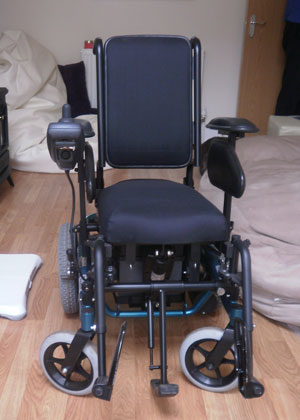Despite knowing I wouldn’t qualify for a powerchair, the whole process has been utterly demoralising

I might cry. Despite knowing that I didn’t meet the criteria for an NHS electric wheelchair, facing up to the reality that I definitely don’t qualify and there is no more the NHS can do is depressing and demoralising.
After bouncing around the wheelchair provision service and falling through the gaps in the system for at least five years, I’ve waited eight months from the time my GP wrote the prescription for an NHS powerchair until this assessment. That’s eight months out of the 12 that people will be permitted to be sick or disabled, once time limiting of employment support allowance (ESA) comes into play. After which time, we’re all expected to have had a miraculous recovery making us fit for work.
Never mind fit for work, what about fit for life? I’m 35 and, now, despite the level of disability I have, I’ve reached the end of the NHS road for mobility support. It will not provide me with a self-propelling manual wheelchair as I’m not capable of using it, and so considers its obligations met by providing me with an attendant chair, which another person has to push. The NHS is not concerned with the fact that I live alone or that I’m also not eligible for social care support. Those issues are not relevant to NHS criteria.
So what is? Three things:
Need – Although I don’t technically meet the requirement for full-time powerchair use (partly due to my extreme stubbornness in refusing to make my condition worse by using a wheelchair full time) it is easy to make a case for need on the grounds of my frequency of falls, risk, dislocations, pain and fatigue.
Access and environment at home – Despite having moved 12 months ago into a more accessible property, this is not an accessible property. My landlord has been fantastic at making alterations where possible and meeting the cost of them, but replacing and paying for an entire doorway that’s only 12 months old seems a step too far. Unfortunately, this means that even if I qualified on the ability to use the chair safely at home, without other adaptations I’d never be considered for an outdoor powerchair.
Ability to use safely – My flat is very small, and it’s only because I would use a child’s powerchair that we can get one in at all. My fine motor control isn’t sensitive enough to quite get the hang of the chair’s controls, and although I could probably master its outdoor use safely within half an hour, I have to be able to use it safely indoors to meet the criteria. The layout of the flat combined with my poor proprioception meant the likelihood of injury is just too great for the occupational therapist to agree to leave a powerchair here.

I hadn’t anticipated how much of a problem it would be for me to use the powerchair, or how frustrating it would feel. I dislocate getting up from wherever I’m sitting or lying, so to use a powerchair I’d have to endure the dislocations, then add in an extra set each time getting in and out of the powerchair in order to negotiate the inaccessible areas. I couldn’t manage to sit for more than a few minutes in the powerchair without my hips dislocating from the position of the seat anyway.
So, my options are extremely limited. I could move to a fully accessible property – if I could find the money to move and replace all the “big society”-style support I now have. Or I could fundraise for an appropriate powerchair, which for me is the most depressing option. Starting to use a powerchair is a difficult and distressing process, so having to spend time and effort on fundraising for it is emotionally difficult for me, but even if I were in a position to do so, it would still take months.
And remember, because of time limiting ESA I’ve now only got four months left to find myself a theoretical new flat, new support system, new wheelchair, and work. That’s bad enough, but once personal independence payments (PIP), the proposed replacement for disability living allowance (DLA), is introduced, it’ll be even worse. PIP will assess on theoretically available wheelchairs, and, theoretically, there is a wheelchair I could theoretically use. Just not in the real world.
So it’s back to being unable to go anywhere I can’t drive or take a mobility scooter. Back to being unable to access the world, let alone the world of work. At least for now I have DLA to mop up some of these extra costs. Once PIP comes in, I theoretically could have all those things so I won’t need any money to pay for them. And who cares about real world working solutions when we have such well thought out theories? Not the politicians that’s for sure.
• Kaliya Franklin blogs at Benefit Scrounging Scum
